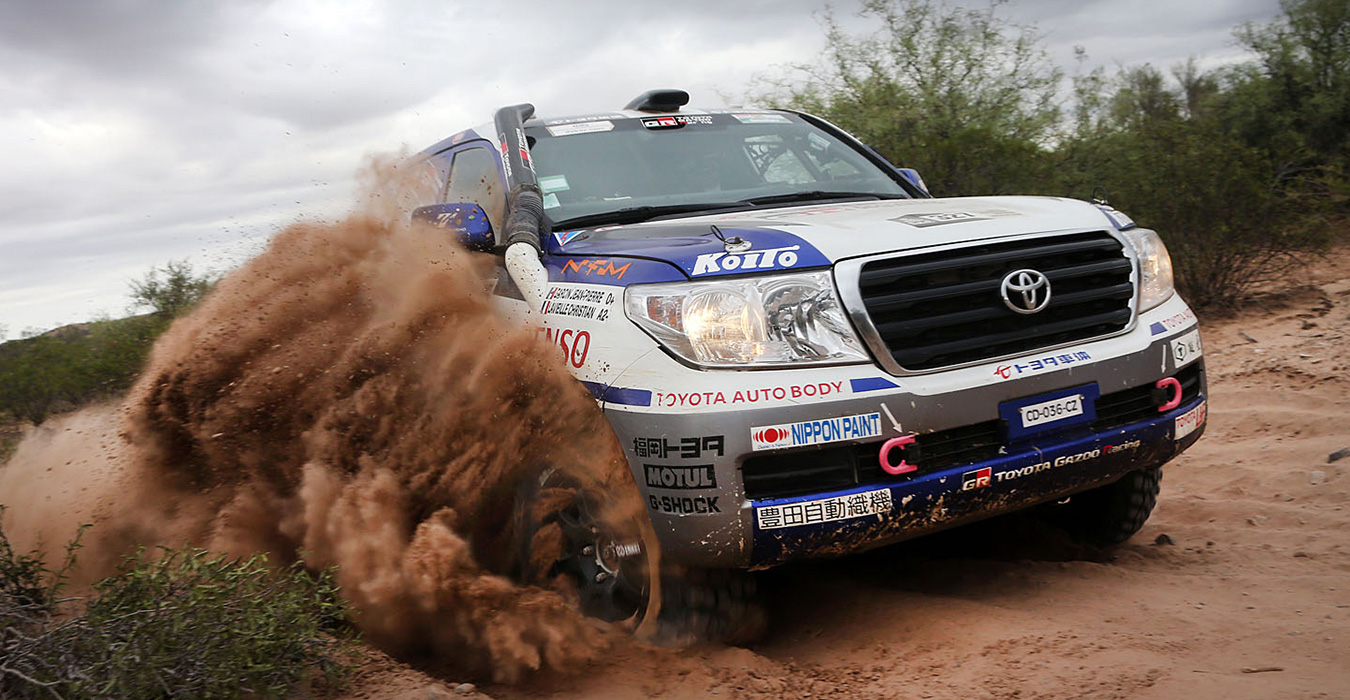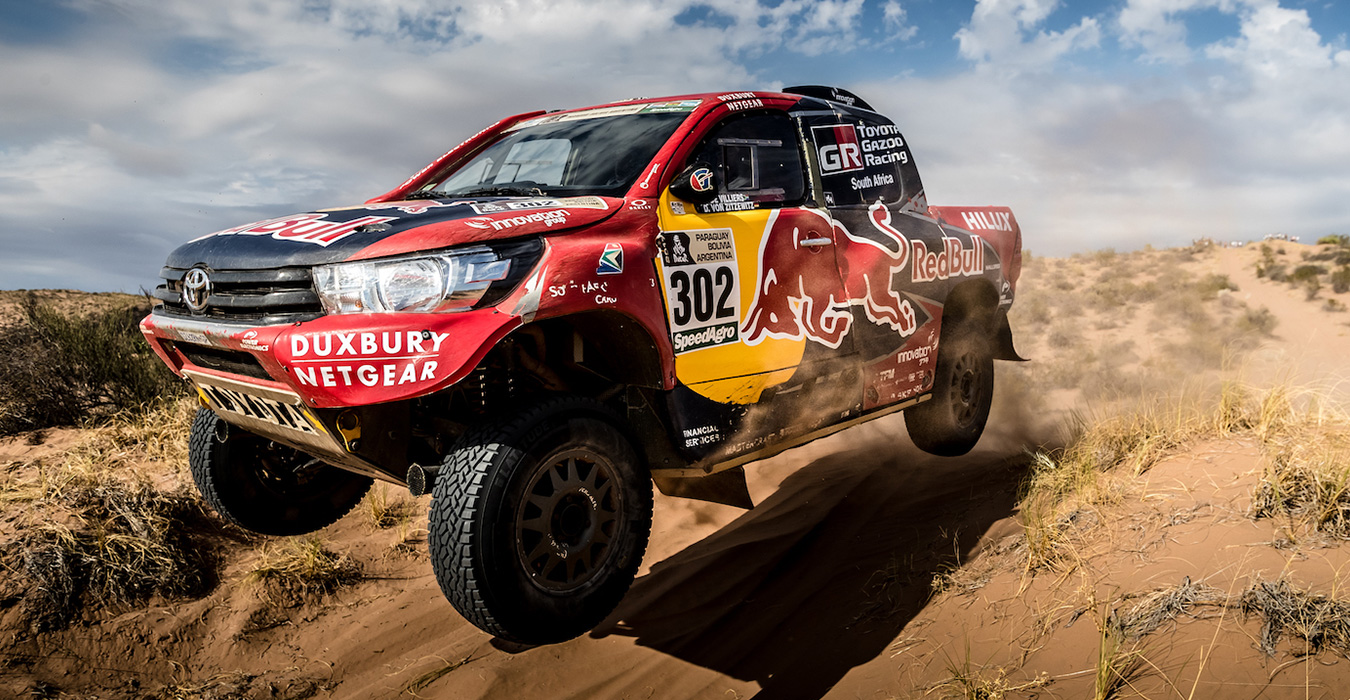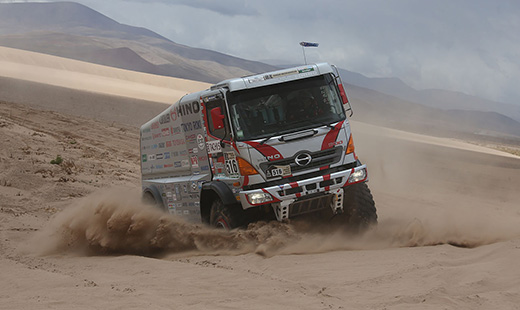Summary of the 2017 Dakar Rally
The 39th Dakar Rally began on January 2nd, 2017, an epic 9,000 km rally-raid through the mountains of Bolivia, the deserts of Argentina and for the first time in Dakar Rally history, the vistas of Paraguay. Without a prologue stage, 79 vehicles kicked off with a challenging 38.96 km special stage from Asunción to Resistencia. Out of the 79 vehicles, 36 were made up Toyota vehicles. Dakar’s first stage with Paraguay was a difficult one. The stage was filled with rocks, water hazards, bumps and holes, all under scorching 40 degree weather. Dakar legend and Toyota newcomer Nasser Al Attiyah, of TGRSA (TOYOTA GAZOO Racing South Africa) took first place. Stage 2’s 275 km rally to San Miguel de Tucumán was no less forgiving, adding large amounts of dust to the equation. By the end, vehicles entering the bivouac were coated in thick mud and nearly unrecognizable.
Beginning at 280 m above sea level in San Miguel de Tucumán, Stage 3 rose to a staggering 4895 m into San Salvador de Jujuy. The 364 km stage was split into two sections; the first filled with sand dunes and “fesh fesh” a superfine dust-like sand; the second section with rocks and holes, bringing disaster for Dakar favorite Nasser Al-Attiyah, who fell into an unseen hole, tearing off his right rear wheel. Not one to quit, Nasser and co-driver Matthieu Baumel quickly piled rocks onto their car to act as a ballast and managed to limp back to the bivouac on three wheels, however, the damage caused Nasser to exit the rally.
Stage 4 continued the high altitude racing, with river crossings and sand dunes to conquer. This is where the rally began to turn due to an opponent that would be ever-present for the majority of the rally: heavy rain and stormy weather. The first casualty of the rain was Stage 5. Although the muddy, difficult to navigate first half of the special stage went ahead, the second half of the stage was simply too dangerous and was cut short.
Due to bad weather conditions, stage 6 was completely cancelled. Alternatively, the competitors were given a direct, yet wet route to La Paz where they were welcomed by thousands of fans in the Bolivian city. La Paz offered a much needed rest day the following day, giving competitors a chance to prepare their strategy for the second half of the race.
The first half of Dakar caused some high profile names to withdrawal early, stages to be cancelled, and navigational errors due to a confusing road book. At this point in the rally Nani Roma (#305 Overdrive Toyota) was in 3rd, Giniel De Villiers (#302 TGRSA) was in 6th and Christian Lavieille and Akira Miura (#327 and #332 TLC – Team Land Cruiser TOYOTA AUTO BODY) were 1st and 2nd in the production category
The second half of the rally began with two days of marathon stages, with Stage 7 taking off from La Paz and heading towards Uyuni. Due to marathon stage rules, competitors could not have mechanical assistance during Stages 7 and 8. Stage 7’s terrain presented a difficult and exhausting sandy challenge, filled with dunes and jumps. Stage 8 entered into Argentina with the strongest weather conditions yet. The competitors faced heavy rain, tall river crossings and deep sand traps. The constant heavy rain triggered a muddy landslide in the Argentine village of Volcan, cutting off the liaison road to the bivouac. Competitors had to follow a 200 km detour causing vehicles to reach the bivouac at early hours the next morning.
Due to the ongoing weather and muddy landslide, stage 9’s 1000km low altitude sprint was cancelled, erasing the chance for many drivers to catch their leading opponents. Stage 10 brought 449 km of hot, rocky, dusty racing with trails filled with bushy vegetation. More navigational errors plagued the stage due to the inadequacies of the road book. Stage 11 marked a 292 km journey towards Buenos Aires filled with an extensive sand section and difficult to navigate narrow trails. The stage was straightforward though when compared to earlier stages in the rally.
Stage 12 to Buenos Aires concluded with a short 64 km special stage providing a quick finale. In the end, after extreme weather changes, navigation havoc, stage cancellations and delays, Nani Roma of Overdrive Toyota finished in 4th place, Giniel De Villiers of TGRSA in 5th place Christian Lavieille and Akira Miura of TLC again displayed dominance by ensuring a 1-2 victory in the production category for the 4th year in a row.
The finish results were promising for Toyota, with 28 out of the 57 cars finishing were Toyota-made. Toyota will continue to make “ever-better” cars through the Dakar experience. The spirit of TOYTA GAZOO Racing push teams to fight even harder next year.
TOYOTA GAZOO Racing SOUTH AFRICA
Team principal: Glyn Hall

-
This was a really rough Dakar, a different type of Dakar for 2017. In the end the big thing is that the Hilux with Nani Roma and Giniel de Villiers with their co drivers won the T1 4x4category. Also until stage 3 we were leading with Nasser but even then we had three Hilux in the top 10 overall and I think that’s great. We will come back fighting harder and we will try to win Dakar 2018. Thank you to everyone for your support we will be back.
#302

-
Driver: Giniel de Villiers
I am a little bit disappointed, because we wanted to fight for the lead and we lost some time and even though we fought with all the team’s strength I think that the Peugeot was too quick and we had no chance to compete. For sure we need to build a 2 wheel drive to compete, especially in the high altitude sections where the heavy four-wheel drive car suffers. We have a two-wheel drive now but we need to develop more so that we can fight for the win next year.

-
Navigator: Dirk Von Zitzewitz
For me, this was a very tough Dakar. Apart from repeated punctures, we had many communication and navigational errors that caused us to fall down the rankings. Of course coming 5th is not bad at all but it is not the position that we were expecting and hoping for. From racing in this year’s Dakar we discovered and came across faults in both the team and in the Hilux, we would like to improve these problems so that we can come back stronger, overcome our rivals and win.
Team Land Cruiser TOYOTA AUTO BODY
#327
 Left: Jean-Pierre Garcin
Left: Jean-Pierre Garcin
Right: Christian Lavieille-
Driver: Christian Lavieille
I am incredibly happy to have been victorious in the production car category. The Land Cruiser is a strong and tremendous car. The management of the team was perfect and overall, a very positive experience.
Navigator: Jean-Pierre Garcin
Many people say that this year’s Dakar Rally was difficult to navigate but I just take this as part of the enjoyment of the challenge. I am very happy that I could join up with the legend Christian Lavieille and win the production car category.
#332
 Left: Laurent Lichtleuchter
Left: Laurent Lichtleuchter
Right: Akira Miura-
Driver: Akira Miura
I was so pleased when I finally reached the goal in Buenos Aires. Coming in second in the production category did not just come from my driving alone but also the perfectly engineered and tuned Land Cruiser as well as the navigation performed by my navigator Laurent Licthtleuchter. If I have the chance again, I’d love to come back with Laurent and win.
Navigator: Laurent Lichtleuchter
This year was filled with heavy rain and extended high altitude sections, so I think that it must have been very tough for the mechanics. However, even through all that, Akira did amazingly well in his second year driving the Dakar. I think he grew as a driver a lot and this is shown by the fact that he came in second in the production category. He is continuing to improve and if I have the chance I feel we can do well again together.
HINO TEAM SUGAWARA
Entering their truck into the under 10-litre class, HINO TEAM SUGAWARA achieved a 1-2 victory for the 8th straight year.
The first half of the Dakar Rally was exceptionally tough, combining torrid cold weather and high altitudes, however the crew were able to soldier on without trouble. The second half of the rally took part in the lowlands but presented its own obstacles, the temperature was high, and the landscape was rugged, filled with rocks, bushes and “fesh fesh” a superfine sand. The Hino teams managed to continue on while their rivals stumbled. With this year passed #535, driven by Yoshimasa Sugawara, now holds the record for most consecutive starts at 33 and most consecutive finishes at 20.
#535

-
Driver: Yoshimasa Sugawara
I am truly proud that a father and son team managed to pull off the 1-2 finish. I could truly feel support of everyone and I want to thank everyone, for they helped me get to the finish.
#516

-
Driver: Teruhito Sugawara
The car’s improvement can finally be seen in this performance. Even though we had the smaller engine we could take on the large vehicles. We had reliability and durability on our side. The aim now is next year where I know we can do even better.
RANKING
| N° | TEAM | VEHICLE | OVERALL POSITION | CLASS POSITION |
|---|---|---|---|---|
| #302 | TOYOTA GAZOO Racing SOUTH AFRICA | HILUX | 5 | |
| #327 | TEAM LAND CRUISER TOYOTA AUTO BODY | LAND CRUISER | 23 | 1 (T2. Class 2) |
| #332 | TEAM LAND CRUISER TOYOTA AUTO BODY | LAND CRUISER | 24 | 2 (T2. Class 2) |
| #301 | TOYOTA GAZOO Racing SOUTH AFRICA | HILUX | - |





